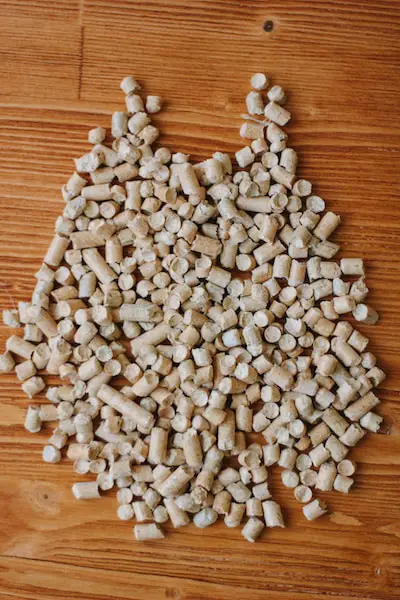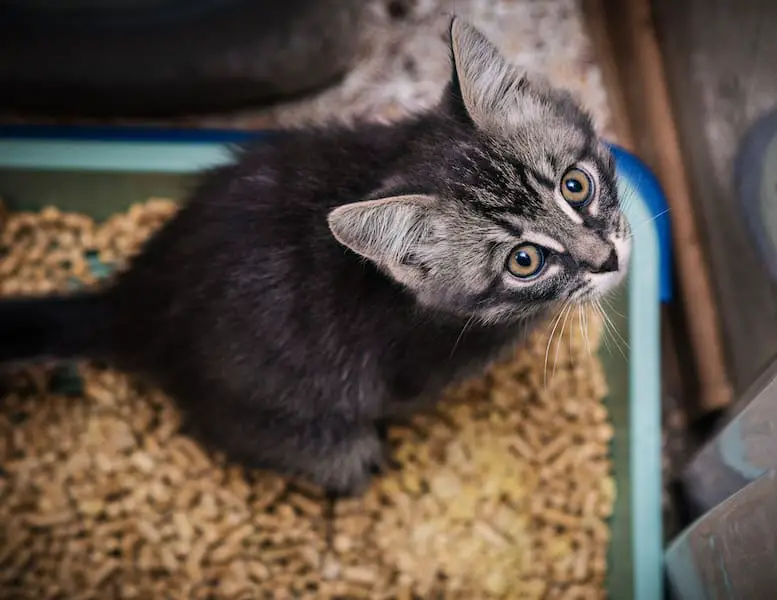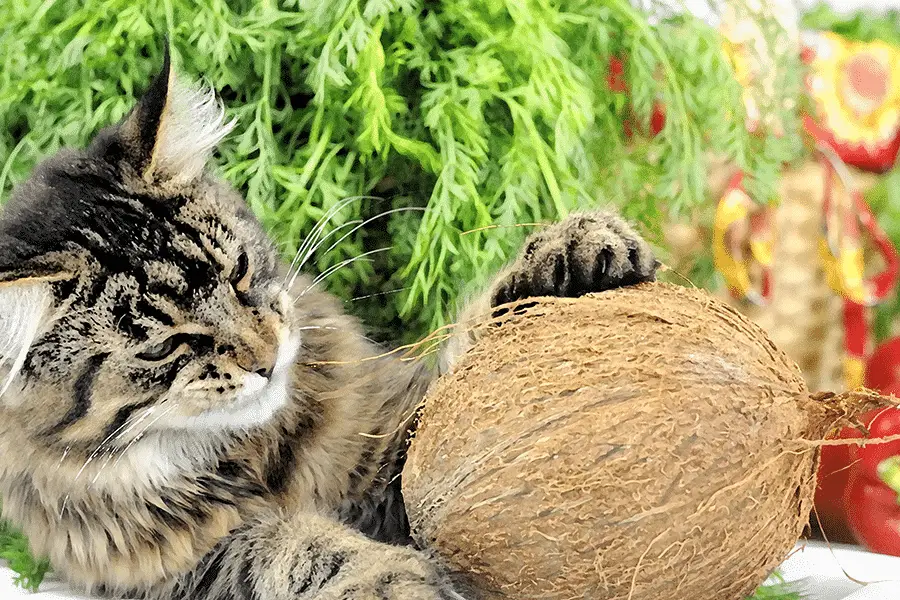Biodegradable cat litter is a big market with a lot of options. More and more, cat guardians are trying alternatives to the popular clumping clay litter in favor of something they hope might be safer for cats and better for the environment. As the demand grows for litter alternatives, more biodegradable litter companies are popping up to fill the need.
Let’s take a closer look at an old favorite and compare it to a promising newcomer in the cat litter space—pine vs. coconut cat litter.
Coconut Cat Litter vs. Pine: Does either litter clump?
Some pine litters include clumping agents, but there aren’t any clumping coconut litters right now.
Some pine litter clumps, some do not. Most pine litter is made of non-clumping pellets. These litters work in a similar fashion to coconut litter—you’ll scoop out the solids and stir up the moistened sawdust to absorb odors. Once the litter has reached its absorbency limit, dump out the contents of the entire box and refill.
If you’re set on using a clumping litter, there is clumping pine litter available. Feline Pine Clumping Litter contains a plant-based clumping agent. There are downsides to the clumping formula, though—the small clumping granules often track and scatter.
Right now, there aren’t any clumping coconut litters on the market. Part of the appeal of coconut cat litter is the complete simplicity of its formula (100% coconut husk)—and the addition of a clumping agent would take away from that. The power of coconut cat litter lies in the natural composition of the coconut husks. The coconut acts like a sponge and quickly absorbs any liquids. Scoop out the solids, stir up the liquids, and you’re set.
Coconut Cat Litter vs. Pine: Which litter delivers better odor control?
Pine cat litter offers awesome odor control, while coconut falls behind in this area.
Pine cat litter wins this round, no question. Pine litter does a great job of absorbing and eliminating the odor of both solids and liquids. Even non-clumping pine litter retains effective odor control for a week. Pine litter also has a very pleasant natural scent—it’s reminiscent of strolling through a freshly thinned forest.
If you’d prefer a completely odorless litter, coconut is a good choice. Coconut litter has no odor whatsoever, so if your cat is extremely sensitive to new odors, he/she may like coconut litter. Unfortunately, coconut litter only controls odors for a couple of days. While the coconut does absorb the urine, it doesn’t eliminate the pungent ammonia smell. Either change the litter more frequently than recommended or add an additional litter odor-eliminator to the box.

Coconut vs. Pine: Which litter is better for the environment?
Coconut cat litter wins this round by a hair—both are super eco-friendly.
Coconut cat litter is made from the waste product of a booming coconut industry. There’s a lot to love about the production of coconut cat litter. Coconut litter is made from coconut husks—the “junk” left over after processing all of your favorite coconut goodies. It’s a renewable resource, and there’s no killing of coconut palms involved. Coconut cat litter is both biodegradable and compostable. Do your research before composting any cat litter, though—it’s important to remove any solid waste and take precautions to ensure your compost is safe.
Pine cat litter is also biodegradable and made from a renewable resource. If you’re worried that purchasing pine litter is contributing to the destruction of forests, remember—most pine cat litter is sustainably manufactured from wood scrap left over after lumber production. Trees are not being cut down to make your cat’s litter, and this way, nothing is going to waste!
Coconut vs. Pine: Which litter is lighter?
Coconut is lighter than pine, but not by much.
Coconut cat litter is incredibly light. If you’re like me, you hate lugging around those heavy buckets of clay litter. It’s hard to pour, and if you have any physical restrictions like back or shoulder problems, you’ll appreciate the trend in lightweight litter.
Light cat litter can be just as effective as a heavy one. The litter box is filled up based on volume, not weight. An entire month’s worth of coconut cat litter is only 5 pounds. Even clay litter branded as lightweight weighs in at over 13 pounds for a month’s supply.
Pine cat litter is also much lighter than clay. If you struggle to carry and pour clay litter, pine is another excellent option. A thirty day supply of pine cat litter weighs about 7 pounds.
Coconut vs. Pine: Which litter is less dusty?
Coconut litter wins this round, hands-down.
Coconut cat litter is the only genuinely dust-free litter. The cat litter market is saturated with promises of dust-free litters, but it’s really difficult to find one which actually delivered on that promise. It makes one wonder if dust-free litter as is elusive as unicorns. Mythological creatures aside, coconut cat litter is seriously, absolutely, 100% dust-free. No dust is apparent when pouring it into the litter box or when the cats are scratching around in it.
Pine cat litter, on the other hand, can be a pretty dusty business. Pine litter usually contains a bit of sawdust in the bag. Even pellet litter can get a little crushed up before it makes it to your cat’s litter box. This sawdust can take to the air as the litter is poured into the litter box but it usually settles down once it’s in the box and doesn’t present much of a problem. Feline Pine adds mineral oil to their formulas in order to keep dust down.
While it’s not as dangerous as the crystalline silica dust found in clumping clay litter, pine dust isn’t entirely harmless. Pine contains plicatic acid in its resin—and this acid can irritate your cat’s respiratory system. It’s unlikely that any negative effects will be noticed unless you or your cat suffers from asthma.
Coconut vs. Pine: Which litter is lower-tracking?
Pine cat litter is lower-tracking than coconut thanks to its extra weight.
Pine litter comes in different shapes and sizes, so the amount of tracking and scatter will vary. As a whole, it’s heavier than coconut, so it’s less likely to stick to kitty paws and track around the house. Your cat may still kick the pine litter out of their litter box, but the pellets or granules usually don’t scatter very far. Pine litter isn’t known for sticking to cats’ fur, either.
Coconut litter tracks and scatters. The lightweight attribute of coconut litter is convenient, but it also makes it prone to sticking to cat paws and tracking out of the litter box. The bits of coconut husk never make it too far outside the box, though—unlike some fine-grained clumping clays, the litter usually falls off quickly and doesn’t get stuck in cats’ toes. If you try coconut cat litter, definitely invest in a quality litter mat.

Coconut vs. Pine: Which litter do cats prefer?
Coconut is soft on the paws, and most cats love the texture.
The fine texture of coconut is similar to fluffy, absorbent dirt. Most cats prefer a litter texture close to fine sand or dirt—and coconut litter isn’t far off. Coconut litter is ideal for cats who enjoy digging around before using the toilet.
Pine cat litter is usually made up of larger chunks and compressed pellets. Pine pellets can be hard on cat paws and they’re not very fun to dig in. If your cat is picky about litter texture, try mixing in their old litter with the pine for a smoother transition.
Coconut vs. Pine: Which litter offers better value?
Pine cat litter beats coconut cat litter with its low price.
The price of the leading pine cat litter, Feline Pine Original, on Chewy. One 7-pound bag of Feline Pine can be found for as low as $5.81 on Chewy.com (not including shipping). One bag will last around one month, so that adds up to $1.45/week.
Compare that to CatSpot coconut cat litter on Amazon.com. A 5-pound bag is available for $17.09. Remember—coconut litter is lighter than pine litter. The 5-pound bag of coconut litter is actually larger than the 7-pound bag of pine! One bag should last approximately one month, so you’ll be paying around $4.27/week.
Both coconut cat litter and pine litter are strong contenders in the biodegradable cat litter space.
Now it’s up to you to decide which one is right for you.
If you’re looking for a safe-for-cats, natural, and eco-friendly litter, both coconut and pine litter are excellent choices. They each have their own strengths and weaknesses—it’s time to narrow it down to which features are most valuable to you and your cat.
Remember, not all cats have the same preferences. For some cats, the most important aspect of their litter is texture—others are so crazy about odor control that they’ll refuse to use a once-soiled box. Know your cat, and maybe give both a try!
Eileen Crusta is the co-founder of Wildernesscat and is dedicated to helping cats live happy, healthy, and adventurous lives at their humans’ sides. Visit Wildernesscat for home remedies, radically natural cat nutrition, nature-fueled lifestyle inspiration, and product reviews.
